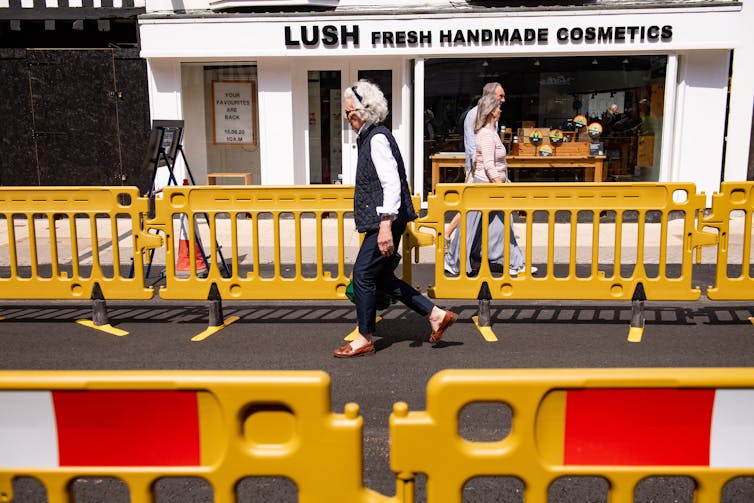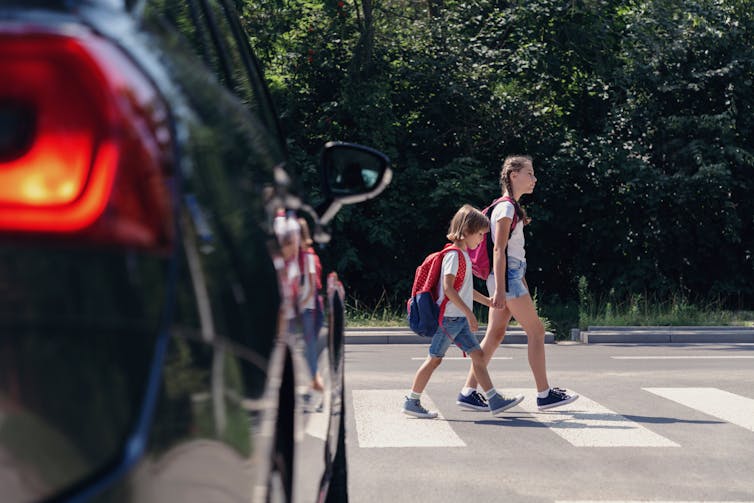The UK has been promised a cycling revolution for decades. In 1996, then-transport minister Steve Norris enthused about quadrupling cycling trips by 2012. Similarly, former prime minister David Cameron promised a “cycling revolution” in 2013 which fizzled out as funding failed to follow. Little has changed for over 50 years. Over this time, cycling trips have been in steep decline. The same is true of walking. Only recently has there been a small increase in cycle use.
But streets empty of cars during lockdown meant that active travel became attractive to a degree not seen for decades. Evidence from Scotland, where I’m based, shows a changing pattern of travel behaviour from March onwards, with 9% of those surveyed saying that they were walking and cycling more and 62% saying that they were driving less. Car use is now back up near pre-March levels but this may well change as winter – and the second wave – progresses.
National campaigns are being run encouraging people to cycle or walk rather than take public transport in an attempt to stop COVID spreading. Small scale funding has been introduced across the UK. Measures include widened pavements, pop-up cycle lanes – often re-allocations of road space from two lane carriageways – and 20mph speed limits.
This may make a difference for some living and travelling along particular corridors where space has been protected, but it won’t help most who might contemplate walking more often or starting cycling: research shows that they want a complete, perceivably safe network. And importantly, the current coverage of COVID-19 policies to support active travel are very much patchwork, with many gaps. Some seem to be being implemented where schemes can be installed quickly, rather than where they are needed most.

It’s understandable that schemes will have their pitfalls – having, after all, been installed incredibly quickly. The hope is that, over time, longer routes will start to be created and networks formed. But the moment must be seized: the coronavirus crisis offers a real opportunity to revolutionise active travel in the UK – with the potential for widespread health, social and environmental benefits.
Sadly, it doesn’t look like this is the case: in October the Transport Secretary appeared to backtrack, writing to local authority leaders instructing them to “balance the needs of cyclists and pedestrians with the needs of other road users, including motorists and local businesses”. Considering ongoing discouragement of the use of public transport there clearly needs to be some significant and clear support for active travel if only to stop urban areas from reaching gridlock if more people feel there is no choice but to drive.
And the ways to achieve this are not speculative – they have been done before, and in the UK.
1. 20-minute neighbourhoods
The concept of the 20-minute neighbourhood encapsulates the idea that everything you need for day-to-day living should be within a 20-minute walk.
Persuading people to stay local is easy enough to achieve in towns and cities because most urban localities already have enough shops and amenities within a 20-minute walk. Active travel can be encouraged by installing modal filters: road blocks or planters installed in residential streets that stop rat-running, forcing most motorised traffic on to main roads while giving direct route access and advantages to those on foot or cycling.
This encourages people away from habitual car use to a norm of walking or cycling. It also helps rebuild communities: people start to see each other routinely on the street, allowing neighbours to connect and build trust.
COVID-19 response funds could make a major contribution here. Versions of 20-minute neighbourhoods have been implemented in the UK. Most well known is London borough Waltham Forest’s Mini-Holland scheme, where over 50 side road junctions have been transformed into “continuous footways” in recent years. Pedestrians have priority over vehicles. Cycle hubs have been established at local train stations. Modal filters discourage through-traffic. Compared to areas elsewhere in London where such schemes have been implemented more slowly, in Walthamstow average survey participants increased their active travel by 41 minutes per week.
2. School street closures
School runs have been a focus of attention in transport policy for over 30 years. How do you achieve high levels of active travel while rates of car ownership are rising and more parents are in work? Most previous interventions have relied on encouraging people to change their behaviour without changing the physical environment. As local champions and keen school staff move on, these schemes have generally failed.
Enter school street closures: simply close the road to motorised traffic ahead of the start and close of the school day. I was positively surprised when I undertook a review of the evidence earlier this year. Despite the road closures only applying to one, two or three roads directly outside primary schools, the results demonstrated significant reductions in car use and a corresponding rise in active travel. In addition, no significant road safety problems arose, such as car migration to neighbouring streets.

3. Scale it up
Both of these examples are relatively simple to achieve. But consistent town and city-wide schemes are needed, and these are trickier. Yet, last year, my colleagues and I identified several successful past such schemes, within the UK, that provided greater support and safety for pedestrians and cycle users.
The Sustainable Travel Towns (2004-9) was one such scheme. Three town programmes put in place a range of initiatives aiming to encourage more use of non-car options. The strategies adopted included the development of a strong brand; travel awareness campaigns; promotion of public transport, cycling and walking; and school and workplace travel planning. Car mileage per person was reduced by up to 10%, compared to a national trend of less than a 1%.
How much did that cost the taxpayer? A miserly £10 million shared across the towns. Scaling this up would be a real bargain, especially compared to the poor value for money of the billions spent on roads, and would allow the UK to finally deliver a real revolution in local travel behaviour.

